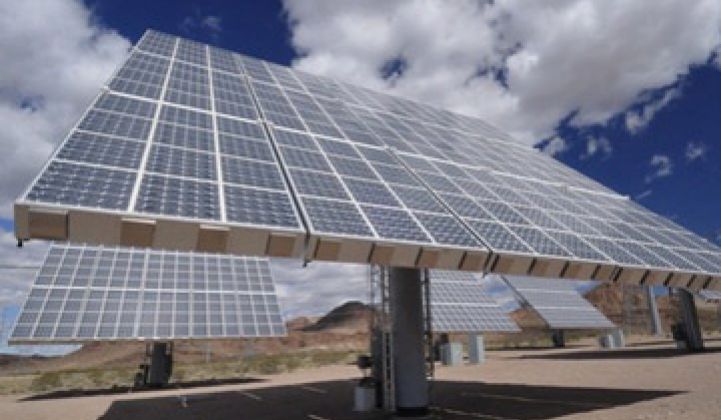Southern California Edison (SCE) has signed 21 contracts for nearly 259 megawatts of power, enough to power more than 168,000 average homes. Twenty of the contracts are for electricity produced by solar photovoltaic projects, and one is for 19.5 megawatts of wind power. The bulk of the agreements are with Silverado Power, a solar PV firm based in San Francisco.
Those are contracts, power purchase agreements, and that doesn't mean they are all going to get built -- but this is still big news for a number of reasons.
It means that utility-scale solar in the U.S. is starting to become significant as evidenced from these utility solar profiles, just a few of the projects online or coming online:
-
50-megawatt Turning Point Solar project in Ohio
-
16-megawatt Blue Wing solar project in Texas
It means that solar is starting to become competitive with some traditional sources of power like natural gas peaker plants. It's notable that there are a number of developers with bids -- these folks believe they can make money.
And it means that concentrating photovoltaics from the likes of Amonix and others might actually start to become a viable utility-scale energy source. Some members of the media have been less than optimistic about CPV technology in light of the plunging price of crystalline silicon (c-Si) solar from China and thin-film cadmium telluride (CdTe) from First Solar. But this could serve as a turning point for the technology with more than 25 megawatts of CPV on contract to be built by mid-2013.
Participation in Edison's Renewables Standard Contracts (RSC) program was based on a competitive process. Developers all bid a price, and SCE selected from the lowest up to a capped amount, according to representatives of the company. Here's a link to a PDF presentation about the program. It's a voluntary renewable procurement program for small projects that SCE has held for several years.
|
Firm |
Project |
Technology |
Capacity (MW AC) |
Est. Online |
|---|---|---|---|---|
|
Amonix |
Blythe |
CPV |
4.7 |
6/2013 |
|
Amonix |
Garnet |
CPV |
4.8 |
6/2013 |
|
Amonix |
Littlerock |
CPV |
5.0 |
4/2013 |
|
Amonix |
Lucerne |
CPV |
14.0 |
3/2014 |
|
Clear Peak Energy |
Holiday |
PV |
8.5 |
12/2013 |
|
Foresight Renewables |
Nicolis |
PV |
20.0 |
9/2013 |
|
Foresight Renewables |
Tropica |
PV |
14.0 |
9/2013 |
|
juwi solar |
Sierra View IV |
PV |
19.0 |
3/2014 |
|
juwi solar |
Sierra View V |
PV |
19.0 |
3/2014 |
|
Recurrent Energy |
RE Columbia 2 |
PV |
20.0 |
1/2014 |
|
Recurrent Energy |
RE Columbia 3 |
PV |
10.0 |
1/2014 |
|
Silverado Power |
American Solar |
PV |
15.0 |
4/2014 |
|
Silverado Power |
Central Antelope B |
PV |
5.0 |
4/2014 |
|
Silverado Power |
Central Antelope C |
PV |
20.0 |
4/2014 |
|
Silverado Power |
Lancaster Dry Farm |
PV |
5.0 |
4/2014 |
|
Silverado Power |
Lancaster WAD B |
PV |
5.0 |
4/2014 |
|
Silverado Power |
North Lancaster |
PV |
20.0 |
4/2014 |
|
Silverado Power |
Sierra Solar |
PV |
20.0 |
4/2014 |
|
Silverado Power |
Victor Dry Farm A |
PV |
5.0 |
4/2014 |
|
Silverado Power |
Victor Dry Farm B |
PV |
5.0 |
4/2014 |
But all is not unicorns and rainbows. Craig Lewis, the Director of the FiT Coalition, had this to say: "All of the projects included in the SCE announcement are not scheduled to come online until between two and four years from now. This is a long time to wait to see if a project actually comes online. The reality in California is that the equivalent of four gigawatts of solar needs to come online annually, starting right now, in order to meet the 33 percent RPS mandate by the 2020 deadline. The fact that SCE makes a big deal of waiting 2 to 4 years to see if we get 260 megawatts of renewables is indicative of how badly California needs a comprehensive feed-in tariff."
Southern California Edison is one of the nation’s largest electric utilities and serves a population of nearly 14 million via 4.9 million customer accounts in a 50,000-square-mile service area within central, coastal and southern California.
The independent power producers are responsible for any necessary permitting and conducting environmental impact studies in accordance with local, state and federal jurisdictions. There will be minimal transmission upgrades to accommodate the projects.
SCE expects to deliver between 19 percent and 20 percent of its power from renewable resources under California’s Renewables Portfolio Standard guidelines by the end of 2010. In 2009, SCE delivered 13.6 billion kilowatt-hours of renewable energy -- 17 percent of its customers’ total energy needs. SCE is the nation’s leading purchaser of solar power, and in 2009, it procured approximately 79 percent of all U.S. solar energy, 51 percent of geothermal and 5 percent of wind generation for its customers.



